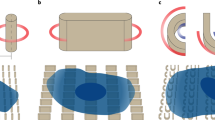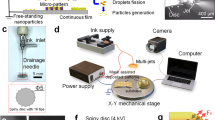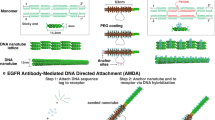Abstract
Programmed subcellular release is an in vitro technique for the quantitative study of cell detachment. The dynamics of cell contraction are measured by releasing cells from surfaces to which they are attached with spatial and temporal control. Release of subcellular regions of cells is achieved by plating cells on an electrode array created by standard microfabrication methods. The electrodes are then biochemically functionalized with an arginine-glycine-aspartic acid (RGD)-terminated thiol. Application of a voltage pulse results in electrochemical desorption of the RGD-terminated thiols, triggering cell detachment. This method allows for the study of the full cascade of events from detachment to subsequent subcellular reorganization. Fabrication of the electrode arrays may take 1–2 d. Preparation for experiments, including surface functionalization and cell plating, can be completed in 10 h. A series of cell release experiments on one device may last several hours.
This is a preview of subscription content, access via your institution
Access options
Subscribe to this journal
Receive 12 print issues and online access
$259.00 per year
only $21.58 per issue
Buy this article
- Purchase on Springer Link
- Instant access to full article PDF
Prices may be subject to local taxes which are calculated during checkout







Similar content being viewed by others
References
Wildt, B., Wirtz, D. & Searson, P.C. Programmed subcellular release for studying the dynamics of cell detachment. Nat. Methods 6, 211–213 (2009).
Ruoslahti, E. RGD and other recognition sequences for integrins. Ann. Rev. Cell Dev. Biol. 12, 697–715 (1996).
Ghaly, T., Wildt, B.E. & Searson, P.C. Electrochemical release of fluorescently labeled thiols from patterned gold surfaces. Langmuir 26, 1420–1423 (2010).
Pesika, N.S., Stebe, K.J. & Searson, P.C. Kinetics of desorption of alkanethiolates on gold. Langmuir 22, 3474–3476 (2006).
Widrig, C.A., Chung, C. & Porter, M.D. The electrochemical desorption of n-alkanethiol monolayers from polycrystalline Au and Ag electrodes. J. Electroanal. Chem. 310, 335–359 (1991).
Yang, D.F., Wilde, C.P. & Morin, M. Studies of the electrochemical removal and efficient re-formation of a monolayer of hexadecanethiol self-assembled at an Au(111) single crystal in aqueous solutions. Langmuir 13, 243–249 (1997).
Mali, P., Bhattacharjee, N. & Searson, P.C. Electrochemically programmed release of biomolecules and nanoparticles. Nano Lett. 6, 1250–1253 (2006).
Chen, C.S., Mrksich, M., Huang, S., Whitesides, G.M. & Ingber, D.E. Geometric control of cell life and death. Science 276, 1425–1428 (1997).
Desai, N.P. & Hubbell, J.A. Solution technique to incorporate polyethylene oxide and other water-soluble polymers into surfaces of polymeric biomaterials. Biomaterials 12, 144–153 (1991).
Kole, T.P., Tseng, Y., Jiang, I., Katz, J.L. & Wirtz, D. Intracellular mechanics of migrating fibroblasts. Mol. Biol. Cell 16, 328–338 (2005).
Hale, C.M. et al. Dysfunctional connections between the nucleus and the actin and microtubule networks in laminopathic models. Biophys. J. 95, 5462–5475 (2008).
Bloom, R.J., George, J.P., Celedon, A., Sun, S.X. & Wirtz, D. Mapping local matrix remodeling induced by a migrating tumor cell using three-dimensional multiple-particle tracking. Biophys. J. 95, 4077–4088 (2008).
Bajpai, S., Feng, Y., Krishnamurthy, R., Longmore, G.D. & Wirtz, D. Loss of alpha-catenin decreases the strength of single E-cadherin bonds between human cancer cells. J. Biol. Chem. 284, 18252–18259 (2009).
Panorchan, P. et al. Single-molecule analysis of cadherin-mediated cell–cell adhesion. J. Cell Sci. 119, 66–74 (2006).
Panorchan, P. et al. Probing cellular mechanical responses to stimuli using ballistic intracellular nanorheology. Meths. Cell Biol. 83, 115–140 (2007).
Kumar, S. et al. Viscoelastic retraction of single living stress fibers and its impact on cell shape, cytoskeletal organization, and extracellular matrix mechanics. Biophys. J. 90, 3762–3773 (2006).
Rajfur, Z., Roy, P., Otey, C., Romer, L. & Jacobson, K. Dissecting the link between stress fibres and focal adhesions by CALI with EGFP fusion proteins. Nat. Cell Biol. 4, 286–293 (2002).
Ezratty, E.J., Partridge, M.A. & Gundersen, G.G. Microtubule-induced focal adhesion disassembly is mediated by dynamin and focal adhesion kinase. Nat. Cell Biol. 7, 581 (2005).
Lewis, L. et al. The relationship of fibroblast translocations to cell morphology and stress fibre density. J. Cell Sci. 53, 21–36 (1982).
Palecek, S.P., Schmidt, C.E., Lauffenburger, D.A. & Horwitz, A.F. Integrin dynamics on the tail region of migrating fibroblasts. J. Cell Sci. 109, 941–952 (1996).
Lazarides, E. & Burridge, K. Alpha-actinin: immunofluorescent localization of a muscle structural protein in nonmuscle cells. Cell 6, 289–298 (1975).
Wakatsuki, T., Schwab, B., Thompson, N.C. & Elson, E.L. Effects of cytochalasin D and latrunculin B on mechanical properties of cells. J. Cell Sci. 114, 1025–1036 (2001).
Ridley, A.J. et al. Cell migration: integrating signals from front to back. Science 302, 1704–1709 (2003).
Griffin, M.A., Sen, S., Sweeney, H.L. & Discher, D.E. Adhesion-contractile balance in myocyte differentiation. J. Cell Sci. 117, 5855–5863 (2004).
Kovacs, M., Toth, J., Hetenyi, C., Malnasi-Csizmadia, A. & Sellers, J.R. Mechanism of blebbistatin inhibition of myosin II. J. Biol. Chem. 279, 35557–35563 (2004).
Laukaitis, C.M., Webb, D.J., Donais, K. & Horwitz, A.F. Differential dynamics of α5 integrin, paxillin, and α-actinin during formation and disassembly of adhesions in migrating cells. J. Cell Biol. 153, 1427–1440 (2001).
Riedl, J. et al. Lifeact: a versatile marker to visualize F-actin. Nat. Methods 5, 605 (2008).
Ballestrem, C., Wehrle-Haller, B. & Imhof, B. Actin dynamics in living mammalian cells. J. Cell Sci. 111, 1649–1658 (1998).
Lee, J.S. et al. Nuclear lamin A/C deficiency induces defects in cell mechanics, polarization, and migration. Biophys. J. 93, 2542–2552 (2007).
Wirtz, D. Particle-tracking microrheology of living cells: principles and applications. Annu. Rev. Biophys. 38, 301–326 (2009).
Dubey, P.K., Mishra, V., Jain, S., Mahor, S. & Vyas, S.P. Liposomes modified with cyclic RGD peptide for tumor targeting. J. Drug Targeting 12, 257–264 (2004).
Acknowledgements
This work was supported in part by NIH Grants R21EB008259 and U54CA143868. B.W. acknowledges support from the Achievement Awards for College Scientists (ARCS) Foundation. We thank members of the Wirtz and Searson labs for technical advice and reagents.
Author information
Authors and Affiliations
Contributions
B.W. conducted experiments. B.W., D.W. and P.C.S. designed experiments, analyzed results and wrote the paper.
Corresponding authors
Ethics declarations
Competing interests
The authors declare no competing financial interests.
Rights and permissions
About this article
Cite this article
Wildt, B., Wirtz, D. & Searson, P. Triggering cell detachment from patterned electrode arrays by programmed subcellular release. Nat Protoc 5, 1273–1280 (2010). https://doi.org/10.1038/nprot.2010.42
Published:
Issue Date:
DOI: https://doi.org/10.1038/nprot.2010.42
This article is cited by
-
Tracking mechanics and volume of globular cells with atomic force microscopy using a constant-height clamp
Nature Protocols (2012)
-
An integrated device for patterning cells and selectively detaching
Biomedical Microdevices (2012)
-
The physics of cancer: the role of physical interactions and mechanical forces in metastasis
Nature Reviews Cancer (2011)
Comments
By submitting a comment you agree to abide by our Terms and Community Guidelines. If you find something abusive or that does not comply with our terms or guidelines please flag it as inappropriate.



